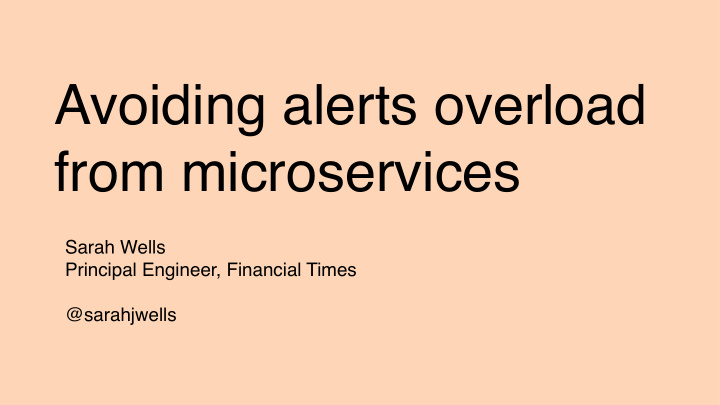



Avoiding alerts overload from microservices Sarah Wells Principal Engineer, Financial Times @sarahjwells
Knowing when there’s a problem isn’t enough @sarahjwells
You only want an alert when you need to take action
Hello @sarahjwells
1
2 1
2 1 3
4 2 1 3
Monitoring this system… @sarahjwells
Microservices make it worse @sarahjwells
“microservices (n,pl): an efficient device for transforming business problems into distributed transaction problems” @drsnooks
The services *themselves* are simple… @sarahjwells
There’s a lot of complexity around them @sarahjwells
Why do they make monitoring harder? @sarahjwells
You have a lot more services @sarahjwells
99 functional microservices 350 running instances @sarahjwells
52 non functional services 218 running instances @sarahjwells
That’s 568 separate services @sarahjwells
If we checked each service every minute… @sarahjwells
817,920 checks per day @sarahjwells
What about system checks? @sarahjwells
16,358,400 checks per day @sarahjwells
“One-in-a-million” issues would hit us 16 times every day @sarahjwells
Running containers on shared VMs reduces this to 92,160 system checks per day @sarahjwells
For a total of 910,080 checks per day @sarahjwells
It’s a distributed system @sarahjwells
Services are not independent @sarahjwells
http://devopsreactions.tumblr.com/post/122408751191/alerts-when- an-outage-starts
You have to change how you think about monitoring @sarahjwells
How can you make it better?
1. Build a system you can support @sarahjwells
The basic tools you need @sarahjwells
Log aggregation @sarahjwells
Logs go missing or get delayed more now @sarahjwells
Which means log based alerts may miss stuff @sarahjwells
Monitoring @sarahjwells
Limitations of our nagios integration… @sarahjwells
No ‘service-level’ view @sarahjwells
Default checks included things we couldn’t fix @sarahjwells
A new approach for our container stack @sarahjwells
We care about each service @sarahjwells
We care about each VM @sarahjwells
We care about unhealthy instances @sarahjwells
Monitoring needs aggregating somehow @sarahjwells
SAWS @sarahjwells
Built by Silvano Dossan See our Engine room blog: http://bit.ly/1GATHLy
"I imagine most people do exactly what I do - create a google filter to send all Nagios emails straight to the bin" @sarahjwells
"Our screens have a viewing angle of about 10 degrees" @sarahjwells
"It never seems to show the page I want" @sarahjwells
Code at: https://github.com/muce/SAWS @sarahjwells
Dashing @sarahjwells
Graphing of metrics @sarahjwells
https://www.flickr.com/photos/davidmasters/2564786205/
The things that make those tools WORK @sarahjwells
Effective log aggregation needs a way to find all related logs @sarahjwells
Transaction ids tie all microservices together
Make it easy for any language you use @sarahjwells
@sarahjwells
Services need to report on their own health @sarahjwells
The FT healthcheck standard GET http://{service}/__health
The FT healthcheck standard GET http://{service}/__health returns 200 if the service can run the healthcheck
The FT healthcheck standard GET http://{service}/__health returns 200 if the service can run the healthcheck each check will return "ok": true or "ok": false
Knowing about problems before your clients do @sarahjwells
Synthetic requests tell you about problems early https://www.flickr.com/photos/jted/ 5448635109
2. Concentrate on the stuff that matters @sarahjwells
It’s the business functionality you should care about @sarahjwells
We care about whether content got published successfully
When people call our APIs, we care about speed
… we also care about errors
But it's the end-to-end that matters https://www.flickr.com/photos/robef/16537786315/
If you just want information, create a dashboard or report
Checking the services involved in a business flow @sarahjwells
/__health?categories=lists-publish
3. Cultivate your alerts @sarahjwells
Recommend
More recommend